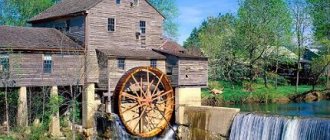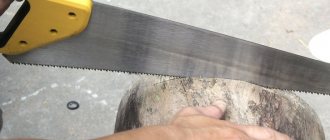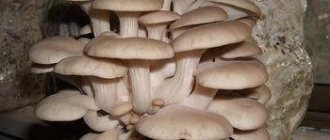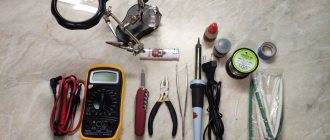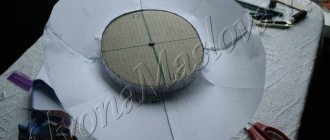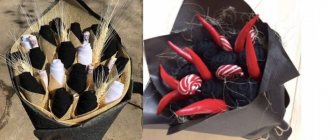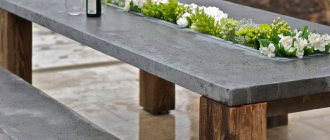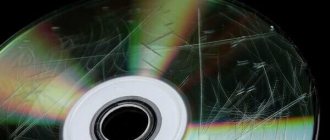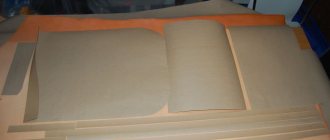Structure for growing oyster mushrooms
FORUMHOUSE user with the nickname 111denis111 made a design that he called “Cradle for Oyster Mushroom”.
If Magomed does not go to the forest, then the forest goes to Magomed. So I had to come up with and design a cradle for growing oyster mushrooms.
The basis of the structure is a metal frame made of a 50x5 angle and round pipes with a diameter of 20 mm.
On top it is covered with a piece of galvanized corrugated sheet, which is tied to wood for strength. The “skeleton” is covered with an agrofibre curtain on ropes, which is secured with clothespins.
In order not to spread dirt in the Oyster Mushroom Cradle and to prevent weeds from entering it, a large sheet of linoleum was laid under the structure. And each leg of the frame is placed on a brick.
The Cradle for Oyster Mushrooms is equipped with a simple irrigation system made of PVC water pipes (20 mm), equipped with spray nozzles.
Mushroom blocks are hung on the suspension. When purchasing blocks, our user recommends being careful and looking closely to make sure there are no mold stains on them.
The only drawback that the users of our portal discovered in this design: it is seasonal, it will stand idle for most of the year, and they suggested thinking about a more capital and heated Cradle.
How to choose a substrate for oyster mushrooms
Experts consider the nutrient substrate to be of decisive importance when growing oyster mushrooms. To successfully grow oyster mushrooms, the nutrient substrate must have high nutritional value and contain proteins, fats, carbohydrates and fiber. The most important thing on this list is proteins, because they determine how quickly the mycelium grows and how well it takes root in the substrate.
Any substrate is made from cellulose-containing materials: first of all, these are the stalks and grains of cereals, corn cobs after threshing, husks from buckwheat grains and peels from sunflower seeds, etc. Champignons, unlike most other mushrooms, are grown in compost, which is rich in nitrogen.
My mother-in-law was pouring champignon peelings onto the meadow. Then cows began to graze there, and now champignons can be picked every morning!
The substrate for oyster mushrooms is made from various grain crops that have different properties.
Thus, millet contains less sugars than other grains, so mushroom blocks made from it are considered the best - oyster mushroom mycelia adapt most quickly to them. Millet also has the lightest grain: this indicator determines how evenly the block is overgrown with mycelium.
After millet in the ranking of substrate blocks suitable for growing oyster mushrooms (and other mushrooms) is rye , followed by barley wheat closes this row . It is not recommended to use oats for preparing mushroom substrates.
When purchasing substrate blocks, you should pay attention to the absence of yellow spots, which may indicate aging of the crop, and, as always when we are dealing with mushrooms, pay attention to odors. Good, high-quality substrate blocks with mycelium always have a pleasant mushroom smell.
It should be remembered that the mycelium grown on wheat blocks has the shortest viability period (the high rate of mycelial growth lasts about two months), for barley and rye blocks - three months, and for millet blocks - more than six months.
Thus, in all respects, the best raw material for growing mushrooms will be millet, followed by rye, followed by barley and wheat.
There are many examples on FORUMHOUSE when the crop was harvested from spent mushroom blocks purchased to fertilize the site.
You buy spent oyster mushroom blocks, put them on a pallet (white side up), cut off the polyethylene, water them three times a day, keep them in the shade, harvest them, and put the remaining blocks into the garden for fertilizer. This is the easiest way.
We asked for eight blocks (straw in polyethylene) with mycelium from a Tajik specialist. The blocks were lying on the street, awaiting removal for disposal. They interested me only as mulch for garden beds, and then the young Michurinist woke up in my soul. The photo shows a five-liter bucket.
Creating conditions and preparing the premises - we comply with the basic requirements
It is not difficult to grow blocks of oyster mushrooms at home, but in order for them to grow correctly and produce a high-quality and healthy harvest, it is necessary to create the most comfortable conditions. There are two ways to grow oyster mushrooms at home:
- Intensive. With this approach, artificial conditions are created that allow you to get more crops and harvest them all year round. The disadvantages include the need to invest in the purchase of additional equipment.
- Extensive. The natural option for growing oyster mushrooms, in which the amount of harvest depends on external environmental factors, does not require any investment, and the yield of mushrooms cultivated in this way is lower, and they are collected only in the summer season.
Both methods have their advantages and disadvantages, and each of them is suitable for growing at home, since the technology of planting and care is practically the same.
First of all, a cellar, basement, garage or other suitable room in which mushrooms will grow is equipped in compliance with all conditions, the main of which are as follows:
- Comfortable temperature. The cellar or basement should be constantly warm in the range from +12 to +20. Walls, floors and doors are insulated with special thermal insulation materials. To obtain the required heating parameters in the cold season, additional heaters or infrared lamps are used. During planting of the mycelium, the temperature is increased to 22-25 degrees, during the cultivation process it is again lowered to the recommended limits.
- Air humidity and ventilation. Oyster mushrooms, unlike many other types of mushrooms that are suitable for home cultivation, are moisture-loving. Therefore, the room in which they grow must be humidified to an average level of 75-90%.
- Ventilation and lighting. For normal growth and development of the fungus at all stages, it needs clean air, so the basement must be equipped with a high-quality ventilation system with additional exhaust. Oyster mushrooms do not require much lighting, but they will not grow in the dark either, so fluorescent lamps should be installed throughout the entire area - 1-2 pieces. for 10-15 sq. meters.
- Clean and free of mold or pests. The most important condition for growing oyster mushrooms is the complete absence of mold, mildew, garden pests, insects or dirt. Before laying the blocks, disinfection and cleaning are carried out. The walls can be whitewashed with lime and treated with copper sulfate or a special antifungal liquid.
If there is a smoke bomb, the room is additionally pollinated and left, the floor is washed with a chlorine solution, and if there are pests, everything is treated with biological insecticides.
After creating all the above conditions, the materials in which the mushrooms will be grown are determined. Oyster mushrooms grow well on stumps and small stumps, in glass jars, in briquettes with suitable soil, in baskets, etc.
But the most convenient and practical way for beginners is to grow in blocks or in plastic bags, which are hung on specially equipped plastic (iron ones are not used due to the possibility of rust development) holders or installed on rack shelves.
How to make mushroom blocks
First of all, the raw materials for preparing the blocks must be as fresh as possible; century-old rotten hay or old gray sawdust will not be suitable - mold and other harmful microflora will develop on such raw materials.
If the blocks are made from sawdust and wood chips, then, again, they should have a healthy woody smell; Chemical odors of various varnishes and impregnations are unacceptable. In mushroom growing, only wood chips and sawdust are allowed: nothing will work with conifers.
Many amateur mushroom growers make substrates for growing oyster mushrooms from several different components, for example:
Such a substrate will contain a large amount of nitrogen, which will accelerate the appearance of the first oyster mushroom crop.
All ingredients of the substrate (except for the husk) must be small (each element no more than 3 cm). They are thoroughly mixed and, for disinfection, boiled for three hours in a metal container in hot water (about 70 degrees). The water is drained, the substrate is cooled to 20 degrees and infected with a fungal strain.
I recommend grain mycelium to everyone, it is real and alive. Almost nothing grows on sticks. It doesn’t matter where you buy it, it is important that it be grain-based and, even better, laboratory-produced.
Experience shows that flour and sugar bags (95x56 cm) are ideal for mushroom blocks. Clean bags (preferably even disinfected) are filled evenly, without voids, with the substrate and sprinkled with mycelium (with clean hands).
Pet food
It is not realistic to use the waste from oyster mushrooms as food. If the mixture is straw, then of course you can try it. There are authors who claim that such waste contains a lot of protein. But we must take into account that this is a mushroom protein and in order for animals to eat such food, they must be accustomed to it from childhood. In any case, this mixture should take up no more than 10% of the diet and be completely white, without traces of green or black mold, and without signs of rotting.
Will chickens eat the waste? Most likely, yes, they love to clean up trash. Perhaps they will find larvae, the remains of grains, some pebbles. But it is impossible to consider the spent substrate as significant in the bird’s diet.
How to make an oyster mushroom block correctly
Oyster mushrooms are one of the most unpretentious mushrooms, so their cultivation has gained wide popularity among various types of home businesses. Here we will tell you in detail how to make an oyster mushroom block according to all the rules in order to get a good harvest and avoid possible problems with growing.
After all, a lot depends on the quality of the substrate blocks, and any novice mushroom grower needs to become familiar with all the intricacies of their creation.
What to do with the old block
Three crops can be harvested from one block, and each subsequent one will be significantly worse than the previous one. After the third wave of fruiting, the block can be dismembered into small parts and used to infect a new block. There is no need to buy new mycelium: you can use the leftovers to grow mushrooms of the same quality.
Some break the block after the first wave, and some take the 4th-5th harvest, but I would not call this meager amount of mushrooms a harvest. A block infected with the remains of an old block does not bear fruit as profusely as a block infected with fresh mycelium, but the harvest is still quite good. And most importantly, thanks to the use of waste blocks, you will have free and uninterrupted mushroom production.
- Sulfur-yellow tinder fungus, or “mushroom chicken” - you should definitely try this mushroom!
What to make mushroom blocks for oyster mushrooms from
The substrate block for growing oyster mushrooms is a plastic bag tightly stuffed with nutrient material. Even if you assemble and hang a block according to all the rules, but fill it with low-quality compost, you can’t count on a good harvest. Therefore, it is very important to pay attention to the content.
Substrate preparation
Various materials can be used as the base of the substrate:
To enrich the nutrient medium, the following is added to the raw materials:
It is advisable to grind all components until a homogeneous mass is obtained.
After mixing the components, they are sent for heat treatment. This is a prerequisite to prevent harmful microorganisms from appearing in the substrate.
Place the mixture in a tank of boiling water and cook for 2-3 hours. Then the water is drained, the substrate is cooled and the formation of mushroom blocks for oyster mushrooms begins.
When filling the blocks, the compost should be at room temperature.
What to make mushroom blocks for oyster mushrooms from
Can mushrooms be used as fertilizer?
For fertilizer, ordinary edible mushrooms, boletus, boletus, boletus and other species are suitable, and you can feed yourself and your plants on the site. ... The remains of mushrooms are sent to compost, they rot, and become a valuable fertilizer for plants. Biostimulants can be prepared from mashed mushrooms.
Interesting materials:
Where is the medicine best absorbed? Where is the best place to find Netherite? Where is the best place to relax in Zanzibar? Where is the best place for young people to relax in Abkhazia? Where is the best place to relax in Abkhazia? Where is the best place to order rolls in Moscow? Where is the best place to order spare parts for cars? Where is it better to live in Tyumen? Where are the best cyberpunk implants? Where are the best beaches on the Black Sea?
How to properly form mushroom blocks
For the blocks you will need thick plastic bags measuring approximately 400x800 mm. I also treat them in advance by soaking them in water with bleach. You can use steam treatment or dip them in any other antiseptic solution. It is not necessary to dry them, just shake off the liquid well.
You should also prepare the mycelium in advance. You can buy it in special stores or prepare it yourself.
Layers of substrate and mycelium are alternately placed in the bags. The first and last layers should be made of nutritious material. The mycelium is laid out in a thin layer, the compost in a thick layer.
Bags should not be filled to the very top. You need to leave some free space to tighten the bags well. They are tied tightly with nylon rope. Ordinary ropes will not work here; they will quickly rot from moisture.
Now that the oyster mushroom block is filled with substrate and sealed, cross-shaped cuts are made on it with a sharp knife or blade. The size of the cuts should not exceed 1 cm.
Next, the blocks are placed in a warm room. The first 2-3 weeks are the incubation period. At this stage, it is very important to maintain the correct temperature and humidity levels in the environment where the bags are located. Then the temperature is lowered and the forcing of oyster mushrooms begins. The first fruits begin to emerge from the slits, growing in size every day.
How to properly form mushroom blocks
These were the basic rules on how to make your own oyster mushroom block. There is nothing complicated about it. The main thing is high-quality mycelium and compliance with all conditions in the room. Then the harvest will be rich and of high quality.
Source
Incubation of oyster mushrooms at home - how to grow healthy mycelium?
After preventive treatment of the substrate and preparation of the mycelium, they begin inoculation, that is, planting the mushroom body in a nutrient medium. To do this, conditions must be practically sterile. The crushed mycelium and substrate are mixed on a clean table, which is pre-treated with an alcohol solution.
The work is carried out wearing sanitary gloves. The mixed composition is compacted into plastic bags. At the first stage, it is better to use bags with a volume of 5-7 kg. Laying occurs step by step, in layers, that is, for every 5-7 cm of substrate, 0.5-0.7 cm of planting material, and the lower and upper layers must be composed of soil.
Once the containers are filled, they are tied tightly and perforated. To do this, use a clean kitchen knife or a sharp blade, the cuts are made in a checkerboard pattern, at an angle of 45 degrees, each width is no more than 3-5 mm. After this, the well-compacted mixture of mycelium and nutrient substrate is transferred to a room with a constant temperature of at least 23 degrees and suitable air humidity.
The slightest increase in temperature negatively affects germination due to the risk of thermal shock, especially if for some reason the thermometer shows more than 30 degrees. At the first stage of fungal development, make sure that the room is clean; to do this, wet cleaning is carried out every 2-3 days with the addition of disinfectants.
Under such conditions, the incubation period for development will occur within 2-4 weeks, depending on the type and quality of the mushroom mycelium.
Mushroom blocks are placed horizontally or vertically on shelves or hangers, so that the perforated side has constant access to clean air, and the distance between them should be 4-5 cm. During incubation, the hood should not be running in the room, and it is better to close the ventilation, so Because the carbon dioxide released in the process only contributes to fast and good growth.
Composition and properties of spent mushroom compost
The compost from the used block is natural, it includes mushroom mycelium (structures consisting of protein), which is processed during the process of decomposition, as well as peat, ash, straw, manure (usually horse) or droppings. It may also contain other components depending on the variety of mushrooms grown.
If we talk about the macroelements that make up compost from waste blocks, they include calcium and potassium, phosphorus, nitrogen, etc.
Compost reduces soil acidity, helps improve the substrate, and participates in moisture regulation. Widely used as top dressing in different areas of garden plots - from lawns to greenhouses and ordinary beds.
How to process the substrate at home?
On YouTube they say that everything is simple: pour boiling water over the components that are on hand, let them sit for 5-8-12 hours (recommendations vary greatly) and you can make mushroom bags.
Moreover, any raw material for oyster mushroom substrate is recommended: vegetable and not so much - leaves, cardboard, shavings, sawdust.
Mycelium will not grow at home on such mixtures.
Boiling the substrate, which is also called boiling straw or husks, also does not eliminate defects. Quite the contrary: if the raw material is boiled, then some of the spores not only survive, but also receive thermal activation - after cooling, they swell and grow faster and more aggressively than other spores.
You can take my word for it, or do everything as you read on the Internet, and see for yourself: in the first month, maximum two, the blocks will be overgrown. It may be bad, slow, with spots, but they will happen. Then the marriage will become 100%.
It is advisable to understand one simple thing: oyster mushrooms absolutely do not care how many kilograms of mushrooms you are going to grow per month.
Whether it’s 100 kg or 2 tons, the mycelium can develop well only if the blocks are prepared correctly.
What is the best substrate composition for oyster mushrooms?
Comparison of straw and sunflower husk substrate
At home, it is easiest to grow on the husk.
There are fewer mold spores and bacteria in it, the husks are easier to process - twice as fast in time, easier to pack into bags.
On sunflower husks, primordia appear 2-4 days earlier; the nutritional value in it is higher than in straw.
The straw needs to be chopped using a straw chopper and hay added to it, and the husk is immediately ready for use.
Hay is needed to increase nitrogen so that yields are higher.
What mushrooms to grow?
There are approximately 80 species of mushrooms that are suitable for cultivation on mushroom farms. But only a few varieties are suitable for growing for sale. The most popular industrial mushrooms are champignons (37%) and oyster mushrooms (21.5%).
Also grown on an industrial scale, but on a much smaller scale than oyster mushrooms and champignons, are porcini mushrooms, truffles, shiitake, chanterelles and honey mushrooms.
Champignon
Typically, champignons are grown indoors - garages, basements, greenhouses. 3-4 harvests are harvested per year. The best varieties to grow for sale:
- Hauser A 15;
- Silvan 130;
- Somicel 512, 608, 609.
Pros:
- simple cultivation technology and minimum care;
- Suitable for a variety of rooms;
- are in high demand;
- can be sold in large quantities;
- bear fruit in waves;
- high yield.
Minuses:
- it is difficult to find a high-quality domestically produced substrate - you have to buy compost and cover soil from an imported manufacturer, which increases the cost;
- high competition.
White mushrooms
This mushroom is considered the most valuable in the entire mushroom kingdom. The reason is great taste and nutritional value. The species is in constant demand among consumers.
Advantages of growing porcini mushrooms:
- can be grown both in open ground and in greenhouses;
- high profitability and profit;
- no special training required;
- is in demand.
Minuses:
- symbiosis with certain trees is required;
- it is necessary to create special conditions in the room that are as close to natural as possible;
- For cultivation you need special forest soil.
Oyster mushrooms
Oyster mushrooms are a tasty and productive mushroom that grows in nature on tree trunks and stumps. Cultivated since 1900. At first the mushroom was grown in Germany, then it spread throughout the world. Oyster mushrooms are especially abundant in China.
Best varieties to grow for sale:
- the highest yields (up to 250 kg from 1 ton of substrate) - Px, NK-35, P-24;
- average yields (from 180 to 200 kg per 1 ton of substrate) - P4, P20, P40.
Pros:
- simple growing process;
- consistently high demand;
- any premises are suitable;
- Up to 4 harvests are harvested per year;
- grows on straw.
Minuses:
- it is necessary to change varieties every 3-4 years so that the substrate is not contaminated with specific diseases;
- problems with transportation, since the structure is delicate.
Oyster mushrooms are grown on wheat, barley or pea straw, and the latter increases the yield by 20-25%.
Using spent mushroom blocks as fertilizer
Compost is very valuable in agriculture and has a low cost. Fertilizer has a beneficial effect on increasing the amount of ripened harvest of vegetables and fruits, improves the quality of the soil for flower beds and bushes, since it contains enough nitrogen.
Fertilizing the soil during sowing
In the autumn or spring, while the garden is being plowed, you need to distribute the spent mushroom compost throughout the site in places of future crops. This way you can prepare the foundation, making it more fertile. Plant crops need the components included in fertilizing to support the natural processes of growth and maturation, and immune resistance to diseases. The macroelements contained in compost are absorbed better than in other fertilizers. They enrich soil depleted by chemicals and constant sowing, influence the regulation of soil moisture, preventing it from drying out and making it suitable for abundant fruiting of garden crops.
To obtain the desired results, it is necessary to correctly calculate the required dose of fertilizers applied, depending on the type of soil and the plants planted in it.
Potatoes
Other vegetables
Compost can be used not only for potatoes, but for other crops: fertilizer will increase the fertility of soil structures and the amount of harvest subsequently collected.
The spent mushroom block as a fertilizer improves the process of growth and flowering of garden crops, promotes the accumulation of nutrients by fruits, and the subsequent ripening of berries, vegetables and fruits. The effect is achieved almost immediately: compost increases the yield already in the first year of use. The legume family, greens, and root vegetables (carrots, radishes, beets, etc.) provide increased yield only from the second year of fertilizing the soil with mushroom blocks.
Mushroom bed
Tree transplant
Choose the type of tree according to the preferences of the mushroom:
Birches get along well with porcini mushrooms, black milk mushrooms, and red boletuses. Before replanting a birch tree with porcini mushroom, you need to make sure that there are no oak trees growing nearby in the forest, otherwise the porcini mushroom will form mycorrhiza primarily with the oak. with pine . It works well to transfer a small pine tree into the garden with a grainy oil can.
Values
ID
Java Edition:
| Block | Text ID |
| Brown mushroom block | brown_mushroom_block |
| Red mushroom block | red_mushroom_block |
| Leg of a huge mushroom | mushroom_stem |
Bedrock Edition:
| Color | Text ID | Numeric ID |
| Brown | brown_mushroom_block | 99 |
| Red | red_mushroom_block | 100 |
How to make mushroom blocks without defects
1. Heat treatment of raw materials must be carried out using the hydrothermal method. Here* (link below) the technology is described in detail. It is important to follow all the recommendations from the article, as they are equally important. If you don’t have enough mycelium, or the bags run out, but the steamed husk is still left, you will have to throw it away. You can’t steam it again!
2. The time required for processing does not depend on the volume of the container.
3. The tank, barrel or bathtub in which the heat treatment is carried out must be completely covered (the lid of the tank as well) with foam plastic or foil-coated glass wool. If the container is not insulated, then near the walls the raw material will cool faster, some of it will not warm up, and the likelihood of defects will increase sharply.
So much substrate comes out of a two-hundred-liter barrel that it is enough for 5, maximum 6 mushroom blocks weighing 8.5-9 kg.
4. If you have just started working with oyster mushrooms, you can steam it by pouring hot water. In this case, it is necessary:
- the water must be at such a temperature that after pouring into the raw materials and mixing, the mass has a temperature of at least 80 degrees; - the container is insulated - this is necessary for high-quality heating of the entire husk and so that the temperature does not drop during heat treatment; - Keep sunflower husks at this temperature for at least 4 hours. I don’t recommend this method at all with straw. — after removing the steamed mass, the barrel (steaming tank) must be washed with clean water and treated with a bleach solution (100 g per 1 liter of water).
But this method is ONLY possible! if there is a special room for stuffing substrate mushroom blocks - a clean zone or also called a sowing room (driving room). It must be constantly treated to kill mold spores and bacteria.
And unfortunately, even a clean area does not guarantee that by simply pouring hot water over the raw materials you will be able to avoid green spots, spots of ungrowth, and bacterial contamination.
If this happens, you will have to switch to hydrothermal.
For more details on sowing, how to prepare mushroom blocks, knead the mycelium, stuff plastic bags, make cuts, read this article.
How to add lime
Is it possible to build a business on a mushroom farm?
There is quite a lot of competition in the mushroom market - their cultivation has already been put into production, so you can’t count on big profits. And most importantly, before starting a business, you need to make sure that there are markets.
What you need to open a champignon farm
When starting a business, be sure to analyze the local market in terms of supply and demand. Find out more about future competitors and business risks, master growing technology.
What you will need to start a business:
- Room. Its area should correspond to the scale of production, and its features should correspond to the conditions for growing specific mushrooms. From an area of 100 sq. m harvest 2-4 tons.
- Permission. It is recommended to register as an individual entrepreneur.
To do this, you need to submit an application to open production and pay a state fee. Enter OKVED code 0 1.13.6 “Cultivation of truffles and mushrooms.” To obtain permission, you must submit documents on radiological control, a phytosanitary certificate, certificates of compliance with GOSTs and relevant instructions. - Equipment. To grow mushrooms for sale, you will need an air conditioner, a thermohydrometer, lamps, scales, a steam generator, a boiler for heating water, and a refrigerator. You will also need boxes, shelves, pallets - depending on the chosen growing method.
- Staff. For a small business you will need 3-4 people. They will plant mushrooms, care for the harvest, collect products, process the premises, and maintain optimal conditions.
You can increase the area due to tiers - mushrooms can be grown on several floors. It is also necessary to organize an irrigation system - automatic or manual.
Where to sell finished products?
A prerequisite for the success of a mushroom business is reliable markets. Mushrooms grow constantly, they cannot be stored for a long time, so you need to have several points of sale - to be on the safe side. You can also organize your own point of sale at the market, equipping it with a large refrigerator.
Where can you sell finished products:
- to grocery stores;
- to supermarkets;
- to processing plants;
- resellers;
- to cafes and restaurants.
Experts assure that to start a mushroom business you need at least 700,000 rubles. The money will mainly be used to purchase equipment for growing mushrooms and maintaining the microclimate.
Current expenses per month - 70,000 rubles. The money goes to pay rent, water, electricity, taxes, and salaries to employees. The first mushrooms will be collected only 2 months after the start of the business, so in general, about 1 million rubles will be required to start the business.
1 kg of mushrooms (champignons) retails for about 250 rubles. Wholesale price - 150 rubles. Per 100 sq. m you can collect 2000 kg per month. One mycelium produces 6 harvests. Total per year - 1,800,000 rubles. Profit for the month - 150,000 rubles. Profitability - 25-40%. The business pays for itself in a year or more.
The mushroom business is not without risks:
- Mushrooms may not sprout or die. Such a disaster often happens to novice entrepreneurs who, without sufficient experience, immediately organize large plantations.
- You may be left without a harvest due to diseases or pests. Strict adherence to technology, regular ventilation and cleaning helps to minimize risks.
- It is not always possible to find buyers. Selling the entire harvest is problematic.
Growing mushrooms is an interesting and promising activity that can become a hobby, a business, or just a help in the household. It all depends on the scale and interest of the person who decides to grow mushrooms for the family or for sale. This business does not bring any special profits today, but with proper organization it can easily become a stable source of income.
0
0
Copy link
Here are the main factors:
— number of viable spores
They, as I wrote above, accumulate over time and will certainly cause defects if you do not carry out constant sanitation of the sowing room.
— pH of the substrate
With small production volumes, almost no one controls alkalinity. If there is no defect when the batch becomes overgrown, then most likely the pH is fine.
But when greens (trichoderma) appear in the bags, it is necessary to purchase a pH meter and measure the alkalinity of the finished substrate before stuffing. Alkalinity should be between 7.8 and 8.2. If it is lower, add lime or soda ash during processing. More details - link at the bottom of this article.
— composition of raw materials
The best results at home are obtained from sunflower husks.
There are much fewer competitors in it than in straw, so it takes less time to process the husk - 3 hours. And straw - at least 6 hours. And the yield of mushrooms is higher than on straw alone, to which it is necessary to add legume hay to increase the yield. Do not trust “experienced mushroom pickers” who claim that the mixture can be made from just about anything: sawdust, leaves, tops, paper are not suitable for production, especially at home! After all, you do not have equipment capable of qualitatively processing these materials, heating them to 120 degrees - this is only possible with sterilization, using autoclaves, or at least atmospheric.
— Tree replanting
The longest and most labor-intensive method. It consists of transplanting several young trees from the forest, near which the mushrooms we need were already growing, into the garden. Here you need to be patient, because you will have to wait quite a long time for the harvest, several years.
Although the method is not simple, thanks to it, you can grow the most complex mushrooms, for example, butterfly, which will bear fruit from May to September. Overall, it's worth trying!
When growing wild mushrooms, you should follow a few tips. They will help you, no matter which method of planting mushrooms you choose:
- For planting, choose the coolest time of day.
- The soil must be constantly moist. If possible, organize drip irrigation.
- Place the planting site in dense shade, within a meter radius of the tree trunk.
- In the spring, add fertilizers with a growth activator to the soil.
- The best time to plant mycelium is from late summer to early autumn.
- Forest mushrooms do not take root well under fruit trees.
Consumption of straw and husk for oyster mushroom substrate
Vegetable dry mixtures increase by 2.5 - 3 times when soaked. This depends on the hygroscopicity of the mass and its initial moisture content.
Soaking husks or straw should be carried out not only so that the raw material gains moisture, but also for the spores to swell and begin to grow. Therefore, simply adding water and sowing immediately, without heating, is not an option at all. The spores will be active and will germinate along with the mycelium, the bag will be covered with greenery within 3-4 days.
Soak before heat treatment for at least 8 and no more than 12 hours, for more details see the article* (link at the bottom of the page).



